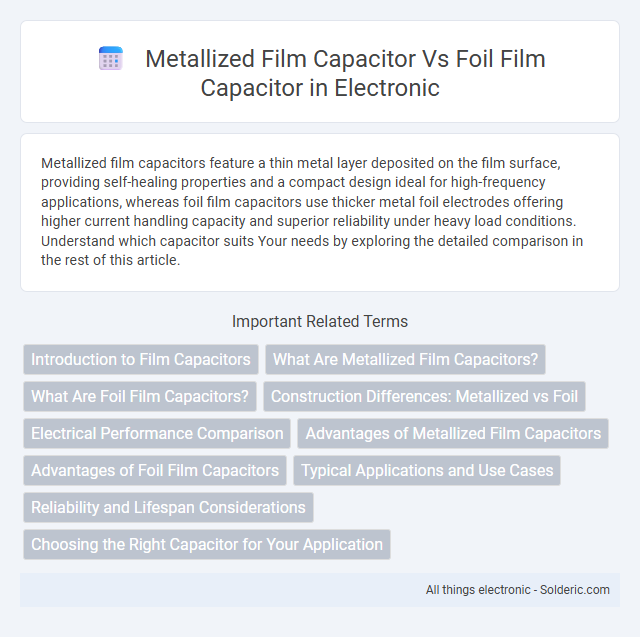Metallized film capacitors feature a thin metal layer deposited on the film surface, providing self-healing properties and a compact design ideal for high-frequency applications, whereas foil film capacitors use thicker metal foil electrodes offering higher current handling capacity and superior reliability under heavy load conditions. Understand which capacitor suits Your needs by exploring the detailed comparison in the rest of this article.
Comparison Table
| Feature | Metallized Film Capacitor | Foil Film Capacitor |
|---|---|---|
| Construction | Thin metalized film deposited on plastic film | Metal foil and plastic film layered separately |
| Self-Healing | Yes, automatically isolates faults | No, prone to permanent damage on faults |
| Size | Smaller, compact design | Larger, bulkier build |
| Voltage Rating | Typically up to ~630 V | Higher voltage handling, often >1 kV |
| Dielectric Losses | Lower dielectric losses | Higher dielectric losses |
| Cost | Generally lower cost | Higher cost due to materials and construction |
| Applications | Signal coupling, filters, energy storage | Power electronics, snubbers, high voltage circuits |
| Reliability | High due to self-healing properties | Moderate, susceptible to failures on defects |
Introduction to Film Capacitors
Film capacitors utilize thin polymer films as dielectric materials, with metallized film capacitors featuring a vapor-deposited metal layer on the film, offering self-healing properties and compact design. Foil film capacitors use metal foils as electrodes paired with dielectric films, providing higher current handling and superior low ESR (Equivalent Series Resistance) performance. Both types excel in stability, low loss, and long service life, but metallized films are preferred for high capacitance in small sizes while foil types suit high-power, pulse, and high-current applications.
What Are Metallized Film Capacitors?
Metallized film capacitors consist of a thin plastic film coated with a metal layer, providing self-healing properties that improve reliability and longevity compared to foil film capacitors. The metallic coating in metallized capacitors enables automatic correction of small dielectric faults by vaporizing metal around defects, enhancing performance in fluctuating electrical environments. Your selection for applications requiring compact size and high voltage endurance benefits from the metallized film capacitor's design advantages over traditional foil film types.
What Are Foil Film Capacitors?
Foil film capacitors use metal foil electrodes sandwiched between layers of dielectric film, providing low equivalent series resistance (ESR) and high current handling capabilities. These capacitors excel in applications requiring high pulse currents and stability under mechanical stress. You can rely on foil film capacitors for superior conductivity and long-term reliability in demanding electrical environments.
Construction Differences: Metallized vs Foil
Metallized film capacitors feature a thin metal layer vacuum-deposited directly onto the plastic film, resulting in a self-healing property where localized shorts are vaporized to maintain capacitor integrity. Foil film capacitors utilize separate metal foil electrodes sandwiched between plastic film layers, offering higher capacitance values and better current handling due to thicker electrode layers but lacking self-healing capabilities. Your choice depends on application requirements for durability, ripple current, and size constraints influenced by these fundamental construction differences.
Electrical Performance Comparison
Metallized film capacitors exhibit higher self-healing properties and better voltage stability under transient conditions compared to foil film capacitors, which provide lower ESR and superior current handling capacity. Metallized capacitors generally have higher equivalent series resistance (ESR) but offer compact size advantages, while foil capacitors deliver enhanced ripple current capability and longer life in high-stress applications. Electrical performance depends on trade-offs between voltage rating, ripple current tolerance, and reliability requirements in specific circuit designs.
Advantages of Metallized Film Capacitors
Metallized film capacitors provide superior self-healing properties, allowing the capacitor to isolate and repair minor dielectric breakdowns without compromising overall performance, enhancing reliability and lifespan. Their compact size and lower weight enable more efficient use of PCB space, making them ideal for high-density electronic designs. You benefit from reduced costs and improved energy efficiency due to their lower equivalent series resistance (ESR) compared to foil film capacitors.
Advantages of Foil Film Capacitors
Foil film capacitors offer superior electrical performance with lower equivalent series resistance (ESR) and higher surge current handling compared to metallized film capacitors. Their robust construction provides enhanced durability and reliability in high-stress applications, ensuring longer operational life. Choosing foil film capacitors can improve your circuit's stability and efficiency, especially in demanding power electronics and audio equipment.
Typical Applications and Use Cases
Metallized film capacitors excel in applications requiring self-healing properties and compact design, such as power supplies, motor run circuits, and pulse handling in consumer electronics. Foil film capacitors are preferred in high-current or high-frequency environments like audio amplifiers, power inverters, and industrial equipment due to their superior current carrying capacity and low equivalent series resistance (ESR). Your choice depends on whether your application prioritizes reliability in varying voltage conditions or demands high stability and robust performance under heavy electrical stress.
Reliability and Lifespan Considerations
Metallized film capacitors offer self-healing properties that enhance reliability by automatically isolating faults, resulting in longer operational lifespans under electrical stress compared to foil film capacitors. Foil film capacitors generally exhibit superior surge current handling and lower equivalent series resistance (ESR), but their lifespan can be reduced due to permanent damage from dielectric breakdown. Reliability in metallized film capacitors makes them suitable for applications requiring extended maintenance intervals, whereas foil film capacitors are preferred in environments demanding high current performance despite potentially shorter service life.
Choosing the Right Capacitor for Your Application
Metallized film capacitors offer self-healing properties and higher energy density, making them ideal for compact electronic designs requiring reliability and longevity. Foil film capacitors provide superior current handling and lower equivalent series resistance (ESR), suited for high-power applications demanding robust performance. Choose the capacitor based on your application's frequency, voltage rating, and size constraints to optimize efficiency and durability.
metallized film capacitor vs foil film capacitor Infographic

 solderic.com
solderic.com